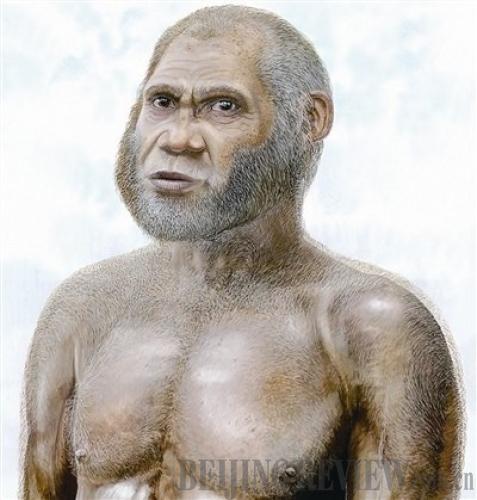|
 |
|
NEW HUMAN SPECIES: An artist's reconstruction of the Red Deer Cave people (FILE) |
A joint team of Chinese and Australian anthropologists announced that they have made an astonishing discovery on human evolution through the research on fossils of a previously unknown group of prehistoric humans, dubbed the Red Deer Cave people, who lived between 14,500 and 11,500 years ago in southwest China.
They recently published Human Remains from the Pleistocene-Holocene Transition of Southwest China Suggest a Complex Evolutionary History for East Asians in PLoS ONE on March 14, 2012. PLoS ONE is an international, peer-reviewed, open-access, online science publication.
The researchers have reconstructed and dated skull remains from a fossil collected by Chinese anthropologists in 1979 from Longlin Cave in Guangxi Zhuang Autonomous Region. They also undertook new excavations at Maludong (or Red Deer Cave) in Yunnan Province to clarify the stratigraphy and dating of a large sample of human remains that were discovered in 1989.
The discovery team, founded in 2008 and co-led by Professor Ji Xueping of Yunnan Institute of Cultural Relics and Archeology and Associate Professor Darren Curnoe of University of New South Wales, includes researchers from six Chinese and five Australian institutions.
Based on three years of work, anthropologists presented new evidence to explain what these human remains might be.
"The Red Deer Cave people look very different to all modern humans, whether alive today or in Africa 150,000 years ago," said Curnoe.
They are "anatomically unique among all members of the human evolutionary tree" with their skulls featuring a mixture of primitive, contemporary and unusual features, said Curnoe.
The skulls have some unusual features, including a broad nose and eye sockets, large molars, a jutting jaw and a prominent brow bone, which looks like Homo neanderthalensis , an early stage of Homo sapiens. But they lived in a period when Neanderthals had been extinct for 28,000 years.
The current evidence shows that the Red Deer Cave people hunted red deer while the ancestors of modern humans in south China were developing agricultural civilization and making pottery.
Alternatively, the Red Deer Cave people could be a previously unknown species of human, an explanation Curnoe cautiously favors.
''While finely balanced, I think the evidence is slightly weighted towards the Red Deer Cave people representing a new evolutionary line,'' Curnoe said.
One possibility might be that the Red Deer Cave people were modern humans who left Africa very early on and reached China, but then did not contribute genetically to people alive in East Asia today. But researchers are not sure whether the Red Deer Cave people had contact with modern humans of the same period.
Geographical conditions might be an important factor. "Southwest China, including Guangxi and provinces of Yunnan and Guizhou, is an enclosed environment with abundant biological diversity because of the separation of the Qinghai-Tibet Plateau and other mountains," said Ji.
"The vast area covered by thick vegetation gradually became a refuge for old species and a cradle for new species," Ji said.
Besides, the rate at which a species evolves is closely associated to the temperature, humidity, altitude and so forth. Therefore, the Red Deer Cave people might have retained their ancient characteristics for a long time and changed very slowly.
The scientists want to look for more answers via genetic research. Over the next year, researchers will attempt to extract DNA samples from remains in both caves. But one of the difficulties is that the DNA breaks down or degrades very quickly in warm areas, Curnoe said.
"The DNA will give us a really accurate handle on where precisely the Red Deer Cave people fit within the human evolutionary tree and would allow us to classify them accurately to know whether or not they are Homo sapiens or they might represent a new evolutionary line," Curnoe said.
The new finding has suggested that the evolution of modern humans in East Asia is much more complicated than people expected before. | 